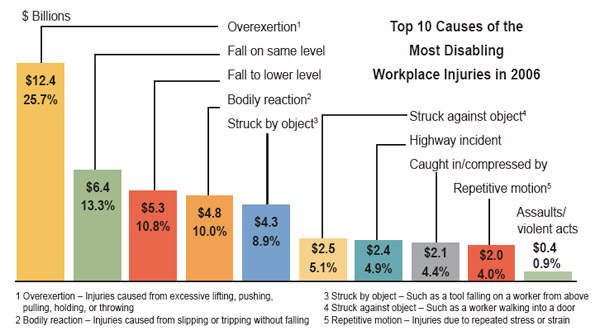 |
||
| |
|
|
Key findings of annual safety report from Liberty Mutual
Every year, the Research Institute produces the Liberty Mutual Workplace Safety Index, a report of the leading causes and costs of the most disabling workplace injuries in the United States. It's a useful tool for workplace safety professionals to better focus their research and injury prevention efforts.

According to this year's Index, the top 10 injury event categories produced 87.9% of the total cost burden of disabling workplace injuries in 2006 – the most recent year for which data were available. In keeping with prior years, overexertion maintained its ranking as the leading cause of occupational injuries. Injuries included relate to lifting, pushing, pulling, holding, carrying, or throwing and accounted for more than one-quarter of the overall national burden (25.7%), and produced $12.4 billion in direct costs to business. Fall on same level events ranked second as a leading cause of disabling injury, generating direct costs of $6.4 billion and accounting for 13.3 percent of the injury burden. Fall to lower level held the third-place ranking; ranked fourth was bodily reaction, which includes injuries resulting from an incident of free bodily motion (such as bending, climbing, reaching, standing, sitting, or slipping or tripping without falling). Struck by object maintained its fifth place ranking, accounting for 8.9% of the total injury cost burden at $4.3 billion.
In addition to the statistics, the report includes findings from research, laboratory and field studies on a wide range of topics including, manual materials handling; slips, trips, and falls; repetitive motion; distracted driving; office ergonomics interventions; handle orientation in cart pushing and pulling tasks, and more. Some of the key findings are:
- There are several modifiable factors influencing the use of personal protective eyewear (PPE) including comfort, fit, training and condition of eyewear and continuous positive reinforcement from supervisors can increase the use of PPE.
- A study of handle orientation on push-pull efficiency for hand trucks and pushcarts suggests that handles should be placed at 61cm or as close to that height as feasible to optimize pulling strength.
- There are significant force and physiologic differences between men and women doing industrial cart-pushing tasks, highlighting the importance of considering the functional abilities when designing tasks.
- A controlled intervention study of the effects of ergonomics training on worker discomfort, computing postures and performance found that participants receiving training reported fewer musculoskeletal and visual symptoms than the non-trained control group. Coupled with an adjustable workstation, training allows workers to change and adjust their workstation and adopt healthy computing behaviors.
- There is a significant geographical variation in Opioid prescribing for acute occupational low back pain. The highest proportion of prescribing was found in the southern region and the lowest in the northeast. State income, household inequality, number of physicians per capita and Workers' Compensation cost–containment efforts explained much of this variation. Individual level factors, including severity, explain only a small portion of the variability.
- A qualitative study to assess the durability of workers who had experienced an injury resulting in an extended period of time off from work found that the most common reasons for leaving work post-injury were environmental factors, including health care provider/employer recommendations, lack of suitable work, having been replaced or company closings. Fewer left because of an inability to perform work-related tasks.
- Workers with recurrent musculosketal pain do find ways to manage workload requirements and deal with pain in informal ways, often without the need for explicit employer consent. The degree to which workers can adjust work methods, vary work activity and make other adjustments on their own to reduce discomfort while still meeting job requirements is key.